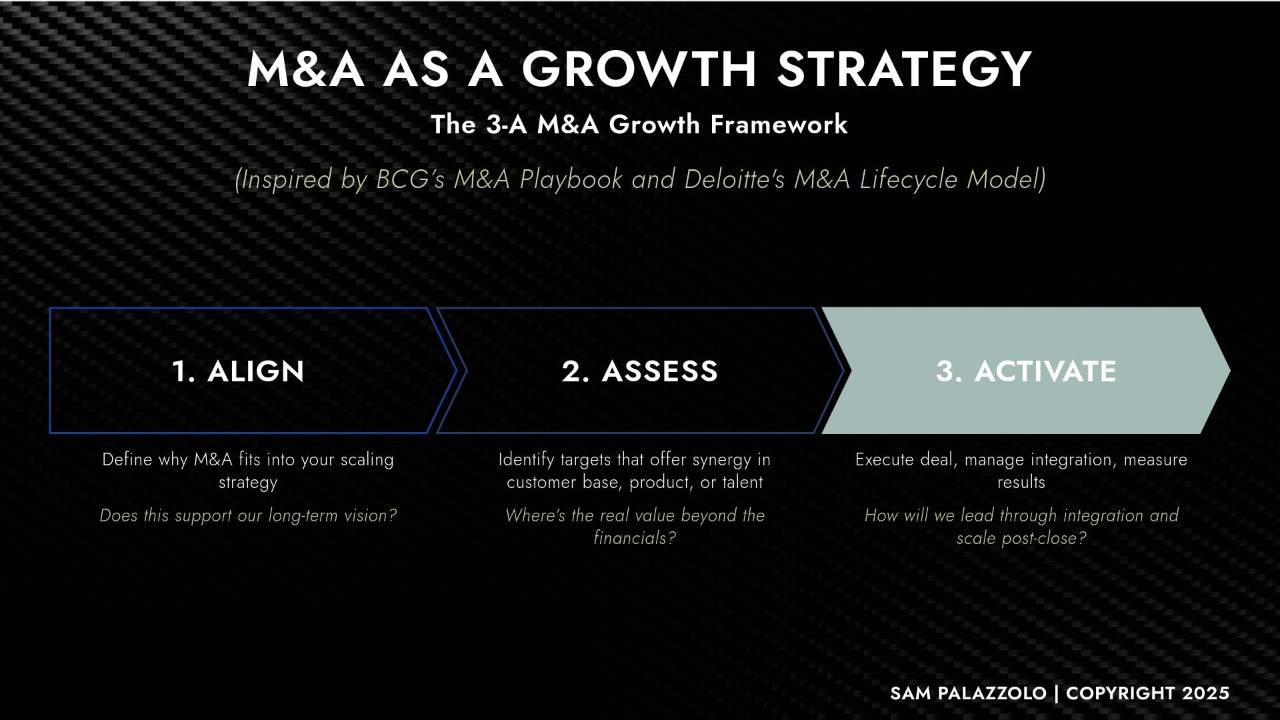M&A as a Growth Strategy: How Leaders Can Scale Smarter, Not Just Bigger
May 04, 2025
Mergers and acquisitions (M&A) offer one of the most compelling—yet complex—growth strategies available. Done well, M&A accelerates market entry, expands capabilities, and creates operational leverage. Done poorly, it destroys value, erodes trust, and derails momentum.
The data confirms the duality: while up to 90% of M&A deals fail to meet expectations (Christensen et al., 2011), those that succeed outperform their peers by 12–18% in Total Shareholder Return (TSR) over five years (McKinsey & Company, 2020).
The question isn’t whether M&A can drive growth—it’s whether your organization is truly prepared to use it strategically.
This article introduces the 3-A M&A Growth Framework, a practical model for scaling with clarity, discipline, and sustainable results.
Why M&A is a Strategic Scaling Lever
Organic growth often faces barriers: saturated markets, limited internal bandwidth, or the slow pace of innovation. M&A can bypass these constraints by acquiring businesses that complement your customer base, extend your product line, or bring in much-needed talent or tech infrastructure.
But M&A is not a shortcut—it’s a capability.
Scaling through M&A requires more than financial acumen. It demands strategic alignment, rigorous assessment, and operational execution. Leaders must be able to answer not just what to buy, but why, when, and how to integrate for maximum value.
Introducing the 3-A M&A Growth Framework
To help leaders navigate M&A as a disciplined growth strategy, I’ve adapted the best elements from BCG’s M&A Playbook and Deloitte’s M&A Lifecycle Model into a simplified structure: Align. Assess. Activate.
1. ALIGN: Connect M&A to Your Vision
Many M&A misfires begin with a fundamental disconnect: the acquisition sounds promising on paper, but doesn’t support the organization’s long-term vision.
Alignment begins with clarity on strategic objectives. Is the goal geographic expansion? Capability enhancement? Customer acquisition?
Leaders must also evaluate internal readiness. Does your team have the structure and capacity to absorb another business? Is leadership aligned on the rationale and desired outcomes?
Key Question: Does this support our long-term vision?
Case in Point: A CEO I advised was excited to acquire a competitor. But the move would’ve distracted them from entering a new, high-growth vertical that better aligned with their strategic plan. We paused, recalibrated, and ultimately pursued a different acquisition that accelerated the right momentum.
2. ASSESS: Look Beyond the Financials
Target identification isn’t just about size or valuation—it’s about synergy. True assessment requires a 360-degree view of the potential target, including:
- Strategic fit: Does the business expand or enhance your value proposition?
- Customer alignment: Are you buying access to a new segment—or creating channel conflict?
- Cultural compatibility: Will their people thrive in your environment?
- Operational and financial metrics: Are there hidden liabilities or underutilized assets?
Many deals fail not because the numbers were wrong, but because integration was an afterthought.
Key Question: Where’s the real value beyond the financials?
Case in Point: A client of mine targeted a high-margin business in their space. On closer inspection, the culture was adversarial, the systems outdated, and integration would’ve cost more than the deal itself. They walked away—avoiding a seven-figure mistake.
3. ACTIVATE: Lead Through Integration
Execution separates scalable acquisitions from expensive distractions. Once the deal closes, the real work begins—integrating teams, systems, cultures, and operations.
A disciplined post-merger integration plan includes:
- A dedicated integration lead or team
- Clear synergy targets and success metrics
- Transparent communication with all stakeholders
- A 90-day operating plan to stabilize and scale
Skipping this phase—or underestimating its complexity—is one of the most common reasons M&A fails to create value.
Key Question: How will we lead through integration and scale post-close?
Case in Point: One organization I worked with created a post-merger command center to manage every integration workstream—from finance and IT to people and brand. Within six months, they achieved 85% of their synergy targets and grew revenue by 22%.
M&A Readiness Is a Leadership Competency
M&A doesn’t belong to finance alone. Scaling through acquisition is a cross-functional effort that requires strategy, operations, people, and capital working in sync.
The 3-A Framework provides a simple but powerful lens for leaders to filter opportunities, avoid missteps, and accelerate value creation.
When leaders treat M&A as a capability—not a tactic—they gain access to exponential growth.
Final Thoughts: From Dealmakers to Scale Leaders
The market will continue to present opportunities to buy. The question is whether your team is ready to scale what they buy.
M&A should not be a reaction to pressure—it should be a proactive choice, deeply tied to your growth model and executed with purpose.
Sam Palazzolo
Real Strategies. Real Results.
PS – If you’re ready to approach M&A as a strategic capability—not a gamble—it’s time to reassess your playbook.
Sign up for my weekly Business Scaling Newsletter at https://sampalazzolo.com to receive more frameworks, insights, and tools to help you lead with clarity and grow with confidence.
SUBSCRIBE FOR WEEKLY BUSINESS SCALING STRATEGIES
REAL STRATEGIES. REAL SOLUTIONS.
We respect your privacy. Unsubscribe at any time.
